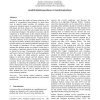Free Online Productivity Tools
i2Speak
i2Symbol
i2OCR
iTex2Img
iWeb2Print
iWeb2Shot
i2Type
iPdf2Split
iPdf2Merge
i2Bopomofo
i2Arabic
i2Style
i2Image
i2PDF
iLatex2Rtf
Sci2ools
AUSDM
2007
Springer
2007
Springer
The Use of Various Data Mining and Feature Selection Methods in the Analysis of a Population Survey Dataset
This paper reports the results of feature reduction in the analysis of a population based dataset for which there were no specific target variables. All attributes were assessed as potential targets in models derived from the full dataset and from subsets of it. The feature selection methods used were of the filter and wrapper types as well as clustering techniques. The predictive accuracy and the complexity of models based on the reduced datasets for each method were compared both amongst the methods and with those of the complete dataset. Analysis showed a marked similarity in the correlated features chosen by the supervised (filter) methods and moderate consistency in those chosen by the clustering methods (unsupervised). The breadth of distribution of the correlated features amongst the attribute groups was related in large part to the number of attributes selected by the given algorithm or elected by the user. Characteristics related to Health and Home, Paid and Volunteer Work an...
| Added | 07 Jun 2010 |
| Updated | 07 Jun 2010 |
| Type | Conference |
| Year | 2007 |
| Where | AUSDM |
| Authors | Ellen Pitt, Richi Nayak |
Comments (0)

